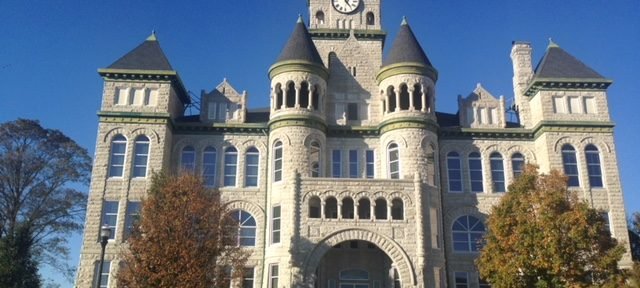Carthage, Missouri was established in 1842 and served as the county seat of Jasper County. The state of Missouri was located between the secessionist southern states and the abolitionist northern states. As a result, several civil war battles occurred in and around Carthage along with very violent attacks from southern guerrillas. The first battle at Carthage occurred on July 5, 1861 and again in October 1863. Carthage was also burned by Confederate guerrillas in September 1864. Carthage, Missouri was reconstructed during the Victorian era.
Thank you for reading this post, don't forget to subscribe!
Carthage from the Civil War and Beyond
As mentioned above the state of Missouri was at a real crossroads at the start of the American Civil War and Carthage, Missouri was one of the flashpoints. Missouri’s loyalties were divided at the outset of the Civil War and the war tore the state apart.
After the civil war, Carthage was a prosperous rail town,as well as a supplier of “Carthage Marble” and a busy highway crossroads when U.S. Highways 66 and 71 came to town in 1926. The new Route 66 from Chicago, Illinois to Santa Monica, California was a economic boost to many towns along it’s path. One of the first concrete-paved portions of Missouri’s highway system was the stretch of road west of Carthage to Joplin, laid in 1920. In 1926, this route became part of Route 66.
Jasper County Courthouse
Carthage enjoys a rich history which is reflected in the many structures found throughout the city.
The current Jasper County Courthouse, built of Carthage stone in 1894, is listed on the National Register of Historic Places. This Romanesque Revival building is constructed of Carthage stone and listed on the National Register of Historic Places. Its turrets, towers and arches evoke the feel of a medieval castle looming over the city below.
The building is great to look at from the outside but even more fascinating when you enter. On the ground floor in the main hallway are cases filled with historic artifacts. There is a case that shows you the mining history, artifacts from Route 66, an old phone booth, and even a mine from the Spanish American War. One of the most interesting features was the mural of the history of Carthage complete with narration.

Carthage Courthouse Square
Carthage Courthouse Square Historic District is, as the name implies, a grouping of shops and stores, most of them with relatively unspoiled nineteenth-century facades, set in traditional Southern fashion around a courthouse.
Carthage Courthouse Square Historic District is significant in American architecture for several reasons. First, it superlatively illustrates the two major phases of post-Civil War commercial architecture — brick Italianate and Romanesque Revival. In addition, the Carthage Courthouse Square Historic District and its side streets contain unusual and beautiful examples of cast-iron ornamentation.
Carthage Civil War Museum
A museum filled with information and artifacts covering the Civil War Battle of Carthage and the Civil War in southwest Missouri. The museum covers the history of the Battle of Carthage, the first full-scale land battle of the Civil War. The museum displays offer an excellent explanation of the several battles and the effects of the War on the area of southwest Missouri .There is also a display on the outlaw Belle Starr, who grew up in Carthage during the Civil War. The museum is located at 205 S. Grant St.
Boots Court-Motel
Another historic structure going back to the days of old Route 66 is the Boots Court-Motel. The Boots Court – Motel was built in 1939 by Arthur Boots, and still carries his name today.

Americans took to the road in unprecedented numbers with the lifting of World War Two rationing and travel restrictions during the Mother Road’s golden age that began in 1945.
The “Motel” was saved from demolition by two sisters who are presently restoring the property to the way it was in 1949, and with the five rooms in the detached annex being completed and opened-for-business in 2012.
Battle of Carthage State Historic Site
This historic site is the location of the final confrontation of the Battle of Carthage, a day-long running skirmish that began on July 5, 1861, about 9 miles northeast of Carthage. Battle of Carthage State Historic Site preserves a small area associated with the battle, as skirmishes were spread over 10 miles. The Battle of Carthage involved the Missouri State Guard, a pro-Southern force, against Union volunteer regiments.

The area is little changed in its appearance since the battle was fought on July 5, 1861. A few minutes off of Interstate 44, the site interprets the battle that set the stage for a decisive showdown a month later at Wilson’s Creek.
You may enjoy our additional articles found on the links below…
Carthage, Missouri features more than 600 buildings listed on the National Registry of Historic Places. These are buildings and structures that at one time housed a wide variety of individuals including Civil War guerrillas, wild west outlaws, business titans, Ragtime musicians and women’s rights pioneers.
Carthage is located just six miles north of Interstate-44 in southwestern Missouri and very close to the Kansas border. The city offers great historic tourist sites that highlight it’s early years including the devastation and battles of the Civil War and the days that Route 66 brought travelers through by the thousands.
It’s a must stop when your travels take you through southwest Missouri and well worth the time.
(Article and photos copyright Trips Into History)

